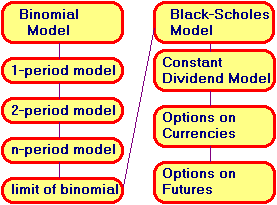1.5
Option Valuation: An Overview
By
now, you know that options allow you to create many different patterns of
payoffs. You can construct positions that allow you to profit from
your information or beliefs, and you can also use options to hedge the payoffs
from an existing position. In
either case, if you buy or sell an option, you will trade at what is called the
option value or the option premium.
How
do you know what is a good price ?
Answering
this question is the subject of what is known as Option Pricing Theory. The basic version of this theory assumes a one-period world
in which the current stock price can move to only two future values.
This is called the one-period binomial model, where "binomial"
refers to the fact that there are only two possible future stock values.
You will learn many of the central concepts of option pricing theory
using this simple model. We then
extend this model to cover many periods; this extension provides the foundation
for studying the option pricing problem in continuous time.
The binomial approach was formalized by Cox, Ross, and Rubinstein (1979),
while the continuous time approach is due to Merton (1974) and Black-Scholes
(1973).
Figure
1.3 depicts the layout of how this book approaches the problem of Option
Valuation
Figure 1.3
Option Pricing Models and Applications

 office (412)
9679367
office (412)
9679367